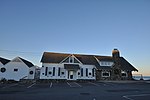Little Boar's Head Historic District
Colonial Revival architecture in New HampshireHistoric districts in Rockingham County, New HampshireHistoric districts on the National Register of Historic Places in New HampshireNRHP infobox with nocatNational Register of Historic Places in Rockingham County, New Hampshire ... and 3 more
North Hampton, New HampshireShingle Style architecture in New HampshireUse mdy dates from August 2023

The Little Boar's Head Historic District encompasses an area of summer resort and beachfront properties in North Hampton, New Hampshire. Located on New Hampshire's seacoast roughly between North Hampton State Beach and Bass Beach, the district is almost entirely residential, consisting mainly of houses built as summer vacation spots in the late 19th and early 20th centuries, with associated beachfront amenities. The district was listed on the National Register of Historic Places in 1999.
Excerpt from the Wikipedia article Little Boar's Head Historic District (License: CC BY-SA 3.0, Authors, Images).Little Boar's Head Historic District
Atlantic Avenue,
Geographical coordinates (GPS) Address Nearby Places Show on map
Geographical coordinates (GPS)
| Latitude | Longitude |
|---|---|
| N 42.96 ° | E -70.779166666667 ° |
Address
Atlantic Avenue 17
03862
New Hampshire, United States
Open on Google Maps









